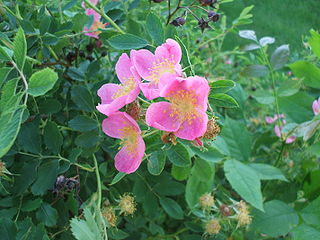
Rosa arkansana, the prairie rose or wild prairie rose, is a species of rose native to a large area of central North America, between the Appalachian and Rocky Mountains from Alberta, Manitoba, and Saskatchewan south to New Mexico, Texas and Indiana. There are two varieties:
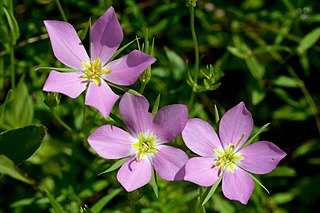
Sabatia campestris is a species of Sabatia, native to the south-central United States, from Texas east to Mississippi and north to Iowa and Illinois. It is also locally naturalized in New England.
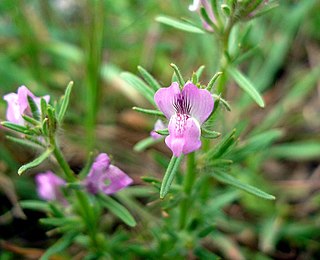
Misopates orontium, known as weasel's snout, is a herbaceous annual plant in the family Plantaginaceae. It is a native of disturbed ground in Europe. It is also naturalised as a weed in other parts of the world such as North America. The pink flowers resemble a miniature snapdragon and are followed by a hairy green fruit which is said to resemble a weasel's snout.

Gentiana andrewsii, the bottle gentian, closed gentian, or closed bottle gentian, is an herbaceous species of flowering plant in the gentian family Gentianaceae. Gentiana andrewsii is native to northeastern North America, from the Dakotas to the East Coast and through eastern Canada.

Gentianopsis crinita is a biennial herbaceous species, native to eastern USA and eastern Canada. The flowers of fringed gentian open on sunny days, but generally remain closed on cloudy days. Individual plants live for only one or two years; the plant is noted as having become relatively rare. It grows in moist, limey woods, meadows, and stream banks.
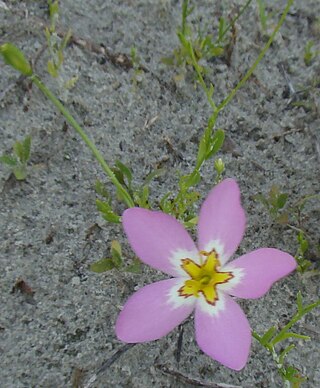
Sabatia stellaris, with the common names rose of Plymouth, marsh pink, salt-marsh pink, and sea-pink; is a species of Sabatia. It has the synonym Sabatia maculata (Benth.) Benth. & Hook.f., Sabatia palmeri Gray, Sabatia purpusii Brandeg., Sabatia simulata Britt.).

Sabatia angularis, commonly called rosepink, rose pink, square-stem rose pink or rose gentain is a biennial flowering plant in the Gentianaceae (gentain) family. It is native to central and eastern North America.
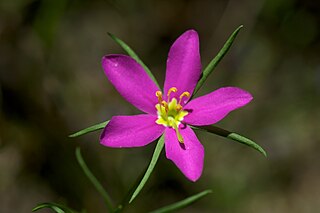
Sabatia arkansana, commonly known as Pelton's rose gentian, is an herbaceous annual in the gentian family. It was discovered in 2001 in several glades of the Ouachita Mountains in Saline County, Arkansas by John Pelton, a retired mechanic turned amateur photographer and naturalist. It is known only from two locations in this county and is considered critically imperiled as a result of the presence of nearby housing developments and due to the absence of a fire regime. In summer it shows attractive rose-purple flowers.

Gentiana alba is a herbaceous species of flowering plant in the Gentian family Gentianaceae, producing yellowish-white colored flowers from thick white taproots. It is native to North America from Manitoba through Ontario in the north, south to Oklahoma, Arkansas and North Carolina, and it is listed as rare, endangered, threatened or extirpated in parts of this range.
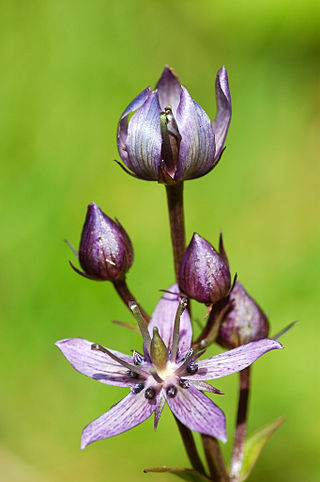
Swertia perennis is a species of flowering plant in the gentian family known by the common names felwort and star swertia. It is native to several regions of the northern hemisphere, including much of Eurasia and western North America. It is a plant of wetlands, particularly calcareous fens. It is common to abundant in many areas, but it is known to be negatively impacted by habitat fragmentation and other habitat destruction, and human activity has led to its extirpation from some areas where it was once common. It is a perennial herb producing usually one erect stem growing 10 to 50 centimeters tall. The basal leaves are spoon-shaped with rounded tips, and leaves higher on the plant are widely lance-shaped or somewhat oval, with pointed tips. The inflorescence is an open panicle of flowers atop the stem. Each flower has a calyx of four or five pointed sepals and a corolla of four or five pointed lobes each up to 1.3 centimeters long. The corolla is dull blue to violet in color with darker purplish veining or stippling. There are two rounded nectary pits at the base of each lobe of the corolla. Stamens tipped with large anthers surround a central ovary.
Gentiana austromontana, the Appalachian gentian, is a 1–2 ft (30–61 cm) tall flowering plant in the Gentianaceae family. It is native to the southern Appalachians of West Virginia, Virginia, North Carolina and Tennessee. Very similar to Gentiana clausa, it has paired, lanceolate leaves, usually on unbranched stalks, and blue or purple blooms which remain closed or nearly closed. It flowers from late August to October. It is thought that G. austromotana is the product of hybridization between G. clausa and G. decora as the Appalachian Gentian is found only in area where the former two are sympatric.

Gentiana saponaria, the soapwort gentian or harvestbells, is a 1–2 ft (30–61 cm) tall flowering plant in the Gentianaceae family.

Sabatia kennedyana is a species of flowering plant in the gentian family known by the common name Plymouth rose gentian. It is native to eastern North America. It has a disjunct distribution, occurring in Nova Scotia, Massachusetts, Rhode Island, Virginia, North Carolina, and South Carolina.

Platanthera flava, the palegreen orchid, is a species of pale-flowered orchid. It is native to eastern North America, from Texas east to Florida, north to Ontario, Quebec and Nova Scotia.

Gentiana puberulenta, the downy gentian, is a branchless perennial plant of the Gentianaceae family native to North America. It is about ¾–1½' tall, with bright blue to deep blue-violet bell-shaped, upright, five-lobed flowers measuring 1½ to 2¼ inches across when fully open. Flowers grow in clusters of 1–8 at the apex of the plant. Lanceolate, sessile, glossy leaves up to 3" long and 1¼" across are arranged oppositely along the central stem, except at the apex where they grow in whorls of 3–7. Gentiana puberulenta grows in dry upland prairies and woods and rocky open slopes.
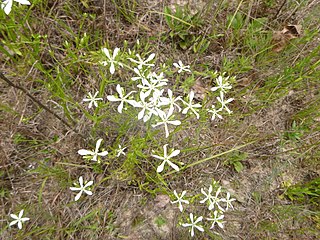
Sabatia quadrangula, the fourangle rose gentian or four-angle rose-gentian, is a flowering plant native to the eastern United States. It is found in pine savannas, flatwoods, shrub bog borders, ditches, and granite outcrops from Virginia south to the Florida panhandle and west to Alabama.

Sabatia campanulata, commonly known as the slender rose gentian or slender marsh-pink, is an herbaceous plant in the gentian family. It is native to the primarily to the southeastern United States.

Triosteum perfoliatum, commonly known as perfoliate tinker's-weed, late horse gentian, common horse gentian, perfoliate-leaved horse-gentian, feverwort, and wild coffee, is a species of flowering plant belonging to the family Caprifoliaceae (honeysuckle). It is found in eastern and central North America. The yellow-orange berries can be dried, roasted, ground, and used as a coffee substitute.

Sabatia brevifolia, commonly known as shortleaf or short-leaved rose gentian, narrowleaf or narrow-leaved sabatia, white marsh-pink or white sabatia, is a species of flowering plant in the genus Sabatia and the family Gentianaceae. It is an annual that grows in moist flatwoods and savannahs. It grows from 1–3 feet tall and the flowers have five white petals with pointed tips.

Sabatia grandiflora is a flowering plant in the genus Sabatia. Commonly known as marsh-pink or largeflower rose gentian, the annual has pink flowers. It grows in parts of Florida and Alabama. The flowers have five pink petals and a yellow center.




















